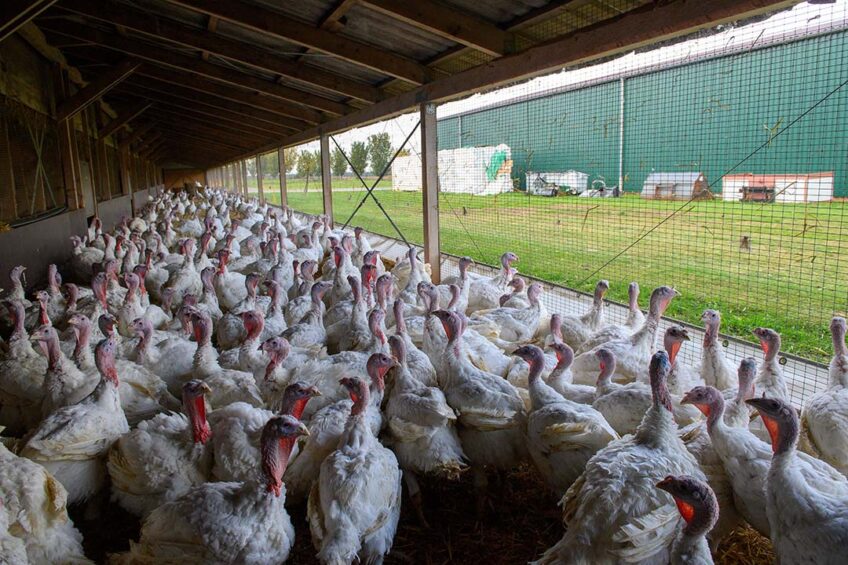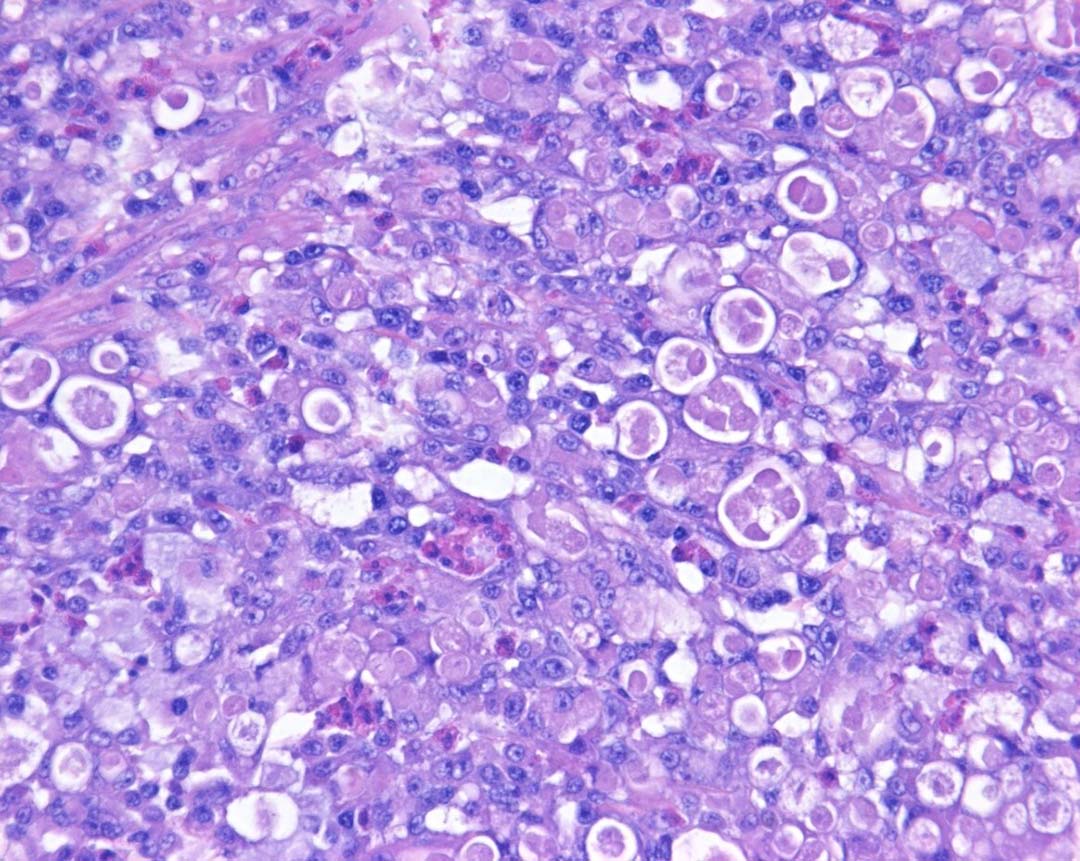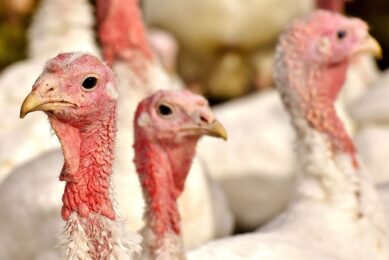The impact of histomoniasis in organic turkeys

To date, there are several unanswered questions concerning histomoniasis and field studies play a vital role in understanding this devastating disease. A case study conducted on an organic turkey farm with a recurrent history of histomoniasis showed that an organic turkey flock (n=3,500) with 30% mortality can lose CAD$42,900 (US$32k ) in value, which at 80% mortality, adds up to CAD$113,946 (US$85.1k).
According to the Canadian General Standards Board organic poultry should be raised under continuous organic management, starting at least from second day of life and fed with organic feed until marketing. No medications should be used at any point, including the fertilised egg.
Organic turkeys have a premium market value globally. Organic turkey feed is more expensive compared to conventional turkey feed and therefore the major expense. Raising organic turkeys is more costly compared to conventionally-farmed turkeys. In return, organic turkey meat sells at a premium price compared to conventional turkey which pays back the producer. In the event of any losses in organic turkey farming, the high investment without return will be devastating. This case study focuses on a histomoniasis outbreak in an organic turkey flock with a recurrent history.
Stricken farm
In the summer of 2021, histomoniasis was reported in a 2-stage organic turkey hen farm (n=3,500) in Canada where 30% mortality was reported while 50% of the flock exhibited clinical signs, such as dullness, depression, drooping wings and yellowish diarrhea. Histomoniasis was confirmed at 35 days of age (d) and samples were collected at 44 d. The site also had a histomoniasis outbreak the previous year.
On necropsy, gross lesions such as necrotising typhlitis, caecal core and multifocal necrotic hepatitis were documented. Caecal samples were collected in 10% neutral-buffered formalin for histopathological evaluation. Liver samples were collected in ice for genomic analysis.
Sections of caeca fixed in 10% neutral-buffered formalin were routinely processed overnight on a Leica Peloris II tissue processor. Paraffin blocks were cut to 5 µm thickness using a Leica RM2255 microtome, stained with hematoxylin and eosin on a Leica ST5020 H&E stainer and cover-slipped with a Leica CV5030 coverslip. Three 5-micron thick paraffin embedded sections were deparaffinised in Xylene and rinsed. DNA was extracted from the liver samples using a DNeasy Blood & Tissue Kit (Qiagen) following the manufacturer’s recommendations.
Primers targeting partial 18S rRNA gene of H. meleagridis were used to amplify the extracted DNA as described before (Bilic and others 2014). PCR reactions were carried out using GoTaq G2 Hot Start Green Master Mix (Promega) with a primer concentration of 5 μM. Two µl of amplicons were visualised in E-Gel EX Agarose Gels, 2% (Invitrogen) with E-Gel 1 Kb plus DNA ladder (Invitrogen). The amplicons were purified using a QIAquick PCR purification kit (Qiagen) and submitted for sequencing.
Devastating losses
The economic impact was estimated and calculated based on interactions and discussions with several turkey (conventional and organic) producers and feed mills in Canada. All the production parameters were calculated for a small size organic farm (n=3,500), including the poult cost, feed cost, utility cost, litter cost, quota levy, equipment cost, repairs and maintenance fees, insurance, property taxes, depreciation and labour costs.
The total income, out of pocket expenses and total losses were calculated for a flock with average performance and a flock with 30% mortality rate, respectively. Because another 50% of the flock showed clinical signs and there was an increased possibility that these would birds die from histomoniasis. Economic losses were also calculated for a flock with an 80% mortality rate.
The organic feed cost for raising organic turkeys up to 91 days would be nearly CAD$87,500 (US$65.3k), while at 30% and 80% mortalities the feed consumption of the flock of may be reduced due to mortalities and morbidity, resulting in costs of approximately CAD$84,000 (US$62.7k) and CAD$65,800 (US% 49.1k), respectively.
Considering all the fixed and variable costs, a producer with a flock of organic turkeys performing normally would expect to make a profit of CAD$36,054 (US$26.9k) (Table 1). A flock with 30% mortality would result in out-of-pocket expenses of CAD$6,846 (US$5.1k) resulting in a total loss of CAD$42,900 (US$32k). A flock with 80% mortality would result in out-of-pocket expense of CAD$77,892 (US$58.2k) and total loss of CAD$113,946 (US$85.1k).
So far, the data available is based on a large-scale estimate of regional and global economic losses due to histomoniasis. To the best of our knowledge, this is the first report to estimate the economic impact of a histomoniasis outbreak in an individual organic turkey flock which considers all the production parameters.
One of many
In recent years, increased outbreaks of histomoniasis have been reported in several countries, such as Canada, Germany and the US. Despite the lack of treatments and commercial vaccines, understanding the pathogenesis of this disease and circulating wild-type field isolates provides valuable insight. Field studies have also revealed the presence of uncommon pathogens in histomoniasis outbreaks.
The intestine has a varied bacterial population with Proteobacteria, Firmicutes, Bacteroidetes and Actinobacteria as the predominant species. Throughout the growing period, the caeca undergo the most changes in microbial diversity. Commercial turkey production with birds raised in high-densities has been shown to impact the caecal microbiome. Overcrowding is also considered a stress factor that could compromise intestinal integrity and increase susceptibility to infectious pathogens. Caecal microbiota are sensitive and assailable, thus any change in managemental factors can affect homeostasis.
Stressors
The histomoniasis outbreak presented here was reported in the summer of 2021. Although histomoniasis outbreaks occur throughout the year, an increased incidence of histomoniasis has been reported in the summer months. It has been suggested that higher temperatures adversely affect intestinal morphology, permeability and microbiota which, in turn, may provide favourable conditions for intestinal pathogens such as H. meleagridis.
Schreier and others have documented that the mRNA expression of caecal tight junction proteins is significantly lower in heat-stressed birds. Any compromise to the tight junctions of the caeca would impair its integrity and alter the bacterial population. Bacteria such as Escherichia coli, Clostridium perfringens or Bacillus subtilis are necessary for H. meleagridis to infect and instill the infection in caeca. In the absence of such a bacterial population, H. meleagridis alone cannot cause the disease. Thus, the presence of a bacterial population determines the virulence of the bacteria.

Shi and others have documented that bacterial population in the phyla Proteobacteria (which includes bacteria such as E.coli), Firmicutes (which includes bacteria such as Clostridium perfringens and Bacillus subtilis) and Tenericutes increased, while Bacteroidetes and Cyanobacteria decreased in the gut of heat-stressed chickens, thus shifting the balance of the bacterial flora in the gut. E.coli is a common bacteria present in the intestine of turkeys. E.coli, being an opportunistic pathogen, can be provoked by any stress factor which, in turn, accelerates growth of the E.coli bacterial population, creating an imbalance in the intestinal bacterial homeostasis, leading to enteric diseases.
In conventional animal production systems, antibiotic growth promoters help in reducing the level of opportunistic pathogens. While in antibiotic-free production systems, there is a greater risk of enteric and systemic diseases as no antibiotics are used. If any factor creates an imbalance in the intestinal bacterial population, then it may indirectly favour the niche for H. meleagridis replication in the caeca. Thus, any factor that may alter the ceacal microbiota can collaterally favour H. meleagridis to invade the caeca.
Additionally, previous histomoniasis outbreaks increase the risk of H. meleagridis outbreaks in successive flocks raised on the same premises. H. meleagridis can survive for several hours in the materials commonly used in poultry production systems. The eggs of Heterakis gallinarum can remain infectious even after 4.4 years. This explains the reason for repeat outbreaks on the same site.
Histomoniasis in a nutshell
Histomoniasis (blackhead disease, histomononosis), an entero-hepatic disease of gallinaceous birds, is caused by a flagellated protozoan, Histomonas meleagridis. The caecal worm, Heterakis gallinarum acts as an intermediate carrier for Histomonas meleagridis and plays a role in histomoniasis transmission. Earthworms act as a paratenic host where H. meleagridis does not undergo any developmental changes and aids in the transmission of histomoniasis.
Several arthropod vectors, such as darkling beetles, have been documented as carriers of histomoniasis. Thus, histomoniasis transmission may occur directly due to the causative organism, H. meleagridis or through vectors or fomites, such as clothes and equipment that can harbour H. meleagridis. Despite variances in severity between gallinaceous species, turkeys are highly susceptible and outbreaks can have up to 80-100% mortality rates.
Clinical signs include depression, anorexia, droopy wings, huddling, lethargy, closed eyes and a tucked up appearance. Affected birds also show apathy, depression and a reluctance to move. In later stages it causes sulphur-yellow diarrhoea which causes feather staining. Diarrhoea increases the moisture content of the litter which further favours H. meleagridis survival in the barn. It is well known that H. meleagridis can survive in water and faeces for up to 9 hours thus, wet and moist litter increase the risk of secondary pododermatitis.
Increased mortalities, decreased performance, culling of sick birds and increased condemnations all contribute to the devastating economic losses caused by histomoniasis. Prophylactic and therapeutic drugs or feed additives used in the past were withdrawn or banned which has resulted in an increased incidence of field outbreaks of histomoniasis worldwide.
No medications or prophylactic measures have been developed to replace these banned therapeutics and H. meleagridis is re-emerging as a pathogen in commercial turkeys.












